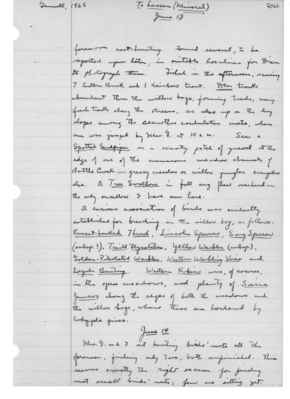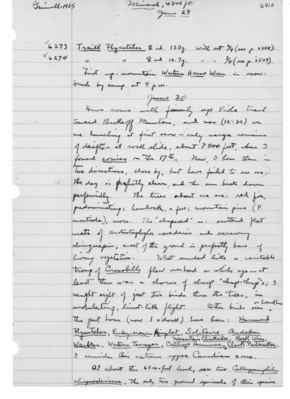Pages That Mention Willow Flycatcher
1925: Joseph Grinnell's field notes
S2 Page 6
Collector: Grinnell - 1925 Location: Lassen Section (Mineral) Date: June 13-14, 1925 Page Number: 2462
forenoon nest-hunting. Found several, to be reported upon later, in suitable locations for Dixon to photograph them. Fished in the afternoon, securing 7 Eastern Brook and 1 Rainbow Trout. Deer tracks abundant thru the willow bogs, forming trails; many fresh tracks along the streams, as also up on the dry slopes among the Ceanothus cordulatus mats, where one was jumped by Mrs. G at 10 a.m. Saw a Spotted Sandpiper on a scanty patch of gravel at the edge of one of the numerous meadow channels of Battle Creek - grassy meadows on willow jungles everywhere else. A Tree Swallow in full song flew overhead - the only swallow I have seen here. A curious association of birds was evidently established for birding in the willow bog, as follows: Russet-backed Thrush, Lincoln Sparrow, Song Sparrow (subsp.?), Traill Flycatcher, Yellow Warbler (subsp.), Golden-Pileolated Warbler, Western Warbling Vireo and Lazuli Bunting. Western Robins were, of course, in the open meadows, and plenty of Sierra Juncos along the edges of both the meadows and the willow bogs, where these are bordered by lodgepole pines. June 14 Mrs. G. and I out hunting birds' nests all the forenoon, finding only two, both unfinished. This seems exactly the right season for finding most small birds' nests; few are sitting yet.
S2 Page 46
Collector: Grinnell - 1925 Location: Mineral Date: June 26 Page Number: 2500
nest found ten days ago, barely began; 3 eggs in nest day before yesterday.
6269 Wright Flycatcher [female symbol] with set 4/4 11.0 g. Had evidently had an accident by which a lot of feathers on back were lost, there being now in process of replacement. Possibly, delayed nesting due to this accident.
June 27 4 p.m. - Cassin Vireo's nest: rim 1750 mm. above ground; nest near end of drooping cedar branch, 7 feet out ^(on south side) from trunk of tree, which is 15 inches in diameter 3 feet from ground. Site about 10 yards from edge of willow bog on one side and less distance from heavy stand of firs, on the other side; lodgepole pines bordering bog close by. This nest was found partly built on the 15th, empty but seemingly completed on the 20th, now with 4 fresh or nearly fresh eggs ^(two of them) and female incubating. Taken, set 2/4. Male bird sang awhile, then went away. After I had waited 20 minute, the [female symbol] came quietly, and I "collected" her.
5 p.m. - Traill Flycatcher nest and set 1/4, taken. Nest, not quite completed, found on 20th, now four eggs, nearly or quite fresh; birds close about me. Nest in dense willow jungle. Rim only 1040 mm. above running water of creek, here entirely overgrown with matted willows. Nest on slanting stems, overtopped by fully 5 feet of lush willow growth.
S2 Page 55
Collector: Grinnell - 1925 Location: Mineral Date: June 28 Page Number: 2508
poising, motionless, at times against the stiff west wind. Mrs. G. found a family of Golden crowned Kinglets in a group of young firs near camp - adults and 4 young, fully grown. I had a clear view of the two of the young - white line over eye, contrasted against dusky or blackish top of head.
June 29 8 a.m. - Traill Flycatcher's nest: in bog, chiefly grown to willow, but some white alder; located out in jungle, alongside of indistinct deer-trail; overtopped, well shaded, by lush green willow and older foliage; rim 1400 mm. above ground, nest insse^securely supported among cluster of upright small willow stems and emanating leaves. Taken (2/4)*, and [female symbol] parent shot.
Russet-backed Thrushes' nest: in same bog as last; rim 780 mm. above ground; situated in rather low willow clump, with larger (taller) clumps of willow and white alder about separated from one another by openings grown to lush grass and buttercup; a meadow stream runs 20 feet away. The green leafage above and all about the nest effectually conceals the nest until parted. The nest is supported on a slanting willow stem plus adjacent twigs and foliage. Taken (1/4)**, and [female symbol] parent taken; [male symbol] heard singing in vicinity mornings and evenings ever since we have been here. Mrs. G. found this nest. The site is almost directly between those of the two
S2 Page 56
Collector: Grinnell - 1925 Location: Mineral, 4800 ft. Date: June 29 Page Number: 2509
Hermit Thrush nests, with young, previously found, these latter being off the edges of the bog on either side, while the Russet-backs is [sic] in the bog.
Traill Flycatcher's nest just found by Mrs. G.; in willow bog only about 100 yards from the other one found today. Rim only 750 mm. above ground; nest in rather open low thicket, of lush leafage, but surrounded by taller growth of willow and alder; supported on slanting willow stem, with other twigs and leafage. Taken (3/4) along with [female symbol] parent. Male birds keep out of sight in willows; heard to sing in usual fashion. Eggs perfectly fresh.
Saw full fledged young Tolmie Warbler in the willows.
6271 Russet-backed Thrush [female symbol] 29.5 g. With set 1/4 (see p. 2508);
6272 Sierra Hermit Thrush [male symbol] ju. 24.0 g. From brood found on June 20 (see p. 2463). As I touched the nest, the four youngsters, even tho seemingly so undeveloped, decamped in as many directions with cries which brot [sic] the distracted mother. Each went over and under logs and bush with amazing celerity; the nest was forsaken for good - the safest procedure to the average, I suppose, in the long run. I found also that the other nest of this species (see p. 2482) had been left by the brood (of about same age) - save for one dead and partly skeletonized, by ants, in the bottom of the nest.
S2 Page 57
Collector: Grinnell - 1925 Location: Mineral, 4800 ft. Date: June 29 Page Number: 2510
6273 Traill Flycatcher [female symbol] ad. 13.0 g. with set 3/4 (see p. 2508). 6274 Traill] [Flycatcher] [female symbol] ad. 12.7 g. [with] [set] 3/4 (see p. 2509).
First up - mountain Western House Wren in snow brush by camp at 4 p.m.
June 30 Have come with family up Viola trail towards Brokeoff Mountain, and now (12:30) we are lunching at first snow - only meagre remains of drifts - at rock slide, about 7500 feet, where I found conies on the 17th. Now, I hear them in two directions, close by, but have failed to see one. The day is perfectly clear, and the sun beats down perfervidly. The trees about me are: red fir, predominating; hemlock, a few; mountain pine (P. monticola), more. The "chaparral" is: scattered flat mats of arctostaphylos nevadensis and scrawny chinquapin; most of the ground is perfectly bare of living vegetation. What sounded like a veritable troup of Crossbills flew overhead a while ago - at least there was a chorus of sharp "chup-chup's"; I caught sight of just two birds thru the trees, in undulating, linnet-like flight. Other birds seen ^or heard here the past hour (now 1 o'clock) have been: Hammond Flycatcher, Ruby-crown Kinglet, Solitaire, Audubon Warbler, Western Tanager, Calliope Hummer,^ Mountain Chickadee, Rock Wren, Clark Nutcracker. I consider this extreme upper Canadian zone.
At about 6500-foot level, saw two Callospermophilus chrysodeirus, the only two ground squirrels of this species




